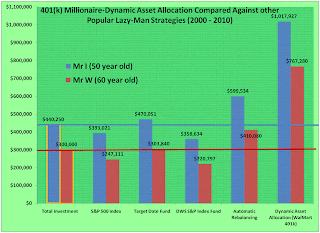Like many individual investors, Mr. Iwaszko made some mistakes in investing. While learning from his mistakes and devoting his efforts to pay for the costs of raising five children, he started investing early by good budgeting, saving early, maximizing his 401k plan contribution and taking full advantage of company's match. Most importantly, Mr. Iwaszko opened himself up to many good investment tactics and benefited greatly from utilizing them.
Mr. Iwaszko studied the stock market diligently, investigated each of the investment choices offered in his company's 401k plan, and carefully chose winners over losers in his investments. These habits, coincidentally, fall into the following three principals that we have been using in our modeling and analysis for retirement plans and mutual fund investment in general.
- Identify good performers in the marketplace
- Filter out noise versus useful information
- Keep winners and cut losers
Mr. Iwaszko didn't simply put his money into index funds and target-date funds, and also didn't use automatic rebalancing methods that many financial institutions now frequently offer through 401k retirement plans. Not because he didn't know these strategies, but rather he trusted himself to make good investment decisions. And as proved in my previous post, "401k Investment Strategy Performance Comparison Put Dynamic Asset Allocation on the Top", these three lazy-man investment strategies simply don't work, especially during times of economic downturn and unfavorable market conditions. We will repost some charts at the end of this writing.
To illustrate how Mr. Iwaszko's technique, which we call dynamic asset allocation, works and performs, we choose Wal-Mart Stores' 401k plan as our example. We assume there is a Mr. I and a Mr. W, who both did a good job with saving and investing like what Mr. Iwaszko had done. In our example the time is in 2000 and Mr. I was 50 year old and Mr. W was 60 year old and retired. Each of them had $300,000 in his (Wal-Mart Store's) 401k plan. Since Mr. I still worked, he kept contributing to his 401k plan, to the maximum amount that the IRS allowed each year. In our calculation we don't count companies' match to an employee's 401k plan account, since each company matches differently.
Max Allowed
Amount
2000 $10,500
2001 $10,500
2002 $11,000
2003 $12,000
2004 $13,000
2005 $14,000
2006 $15,000
2007 $15,500
2008 $15,500
2009 $16,500
2010 $16,500

The following chart shows that the ten-year return comparison between different investment strategies. Mr. Iwaszko's method or the dynamic asset allocation clearly has superior performance over other three popular lazy-man strategies.
 For many investors, they may stress that you don't have Mr. Iwaszko's patience and skills to do the trade. And we understand that and that is where Analytic401k LLC's products and services come into play. To take advantage of Analytic401k.com's dynamic asset allocation service and to save your time, here are a few things you need to do
For many investors, they may stress that you don't have Mr. Iwaszko's patience and skills to do the trade. And we understand that and that is where Analytic401k LLC's products and services come into play. To take advantage of Analytic401k.com's dynamic asset allocation service and to save your time, here are a few things you need to do- Create your 401k plan portfolios on www.analytic401k.com
- Choose the options for your portfolios
- Perform online portfolio analysis
- Wait for monthly emails sent to you with investment suggestion by analytic401k.com
To further help you understand how Mr. Iwaszko or the dynamic asset allocation performs; a bar chart is provided below. The chart shows the same two gentlemen Mr. I who was 50 year old in 2000 and Mr. W was 60 year old in 2000. Both had $300,000 invested in their 401k plan (Wal-Mart Stores Corp). Mr. W has retired and didn't contribute to his plan anymore. Mr. I kept his monthly contributions since he was still working.
This chart clearly shows that if they had used the lazy-man's approach to investing in index funds, target date funds or an automatic rebalance program, they both would have lost money after adjusting for inflation. If they utilized the dynamic asset allocation, they both would have retired either being a millionaire or live like a millionaire in their retirement, with Mr. I's portfolio value increasing from $300,000 to $1,017,970 and Mr. W's portfolio increasing from $300,000 to $767,280.

The lazy-man approaches lose money due to the two economic recessions between 2000 and 2010. There are very few, if any, mutual funds that could beat the market index consistently during that ten year period. Dynamic asset allocation is an investment strategy that seizes opportunities and avoids being trapped in bad investment situations and choices. Here are the three investment principals we listed at the beginning that Mr. Iwaszko and the dynamic asset allocation strategy have followed:
- Identify good performers in the market place
- Filter out noise versus useful information
- Keep winners and cut losers



